
Myrmarachne is a genus of ant-mimicking jumping spiders that was first described by W. S. MacLeay in 1839. They are commonly called antmimicking spiders, but they are not the only spiders that have this attribute. The name is a combination of Ancient Greek μύρμηξ (myrmex), meaning "ant", and ἀράχνη (arachne), meaning "spider".
Bathippus is a genus of jumping spiders.
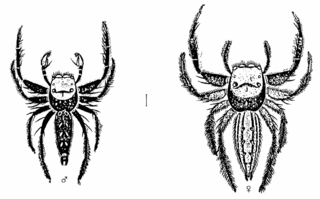
Bavia is a genus of jumping spiders.
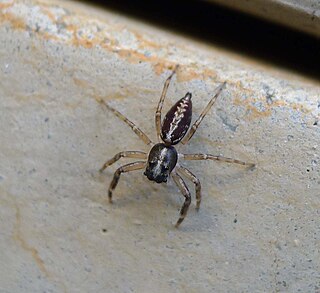
Canama is a genus of spiders in the jumping spider family, Salticidae. Its five described species occur from Borneo to Queensland.

Clynotis is a genus of spiders in the family Salticidae, or jumping spiders, contained within the subfamily Marpissinae. They are found across Australia and New Zealand, with some species occupying the Auckland Islands and one found exclusively on Snares Island. There are eight species currently described within the genus, the earliest noted being the type species Clynotis severus, first described in Queensland, New South Wales, Australia in 1879 by Ludwig Carl Christian Koch. The most recent was described in 1931 by Lucien Berland. Two other species previously held within the genus were subsequently reclassified into the genus Tara.

Cosmophasis is a genus of spiders in the family Salticidae. Some species occur in Africa, while most are found in Southeast Asia, down to Australia. Although most species more or less mimic ants, there are also colorful species that follow a different strategy.

Epeus is a genus of the spider family Salticidae. They are often found on broad-leaved plants or shrubs of rain forest, or in gardens of Southeast Asia.

Hasarius is a spider genus of the family Salticidae.

Hyllus is a genus of the spider family Salticidae.
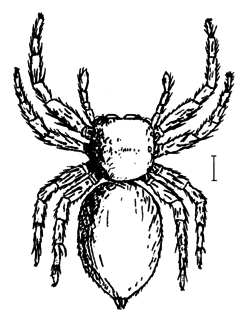
Mantius is a spider genus of the jumping spider family, Salticidae.
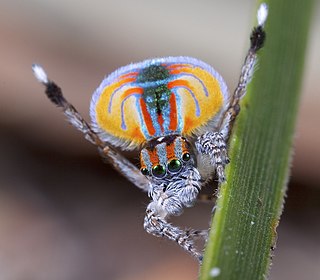
Maratus is a spider genus of the family Salticidae. These spiders are commonly referred to as peacock spiders due to the males' colorful and usually iridescent patterns on the upper surface of the abdomen often enhanced with lateral flaps or bristles, which they display during courtship. Females lack these bright colors, being cryptic in appearance. In at least one species, Maratus vespertilio, the expansion of the flaps also occurs during ritualised contests between males. The male display and courtship dance are complex, involving visual and vibratory signals.
Vailimia is a genus of Asian jumping spiders that was first described by C. F. Kammerer in 2006. It was first described in 1907 from a single male about 6 millimetres (0.24 in) long. It was originally thought to be close to Harmochirus, but the male pedipalp, chelicera, and cephalothorax drawn by Proszynski in 1984, and information gained from later collected specimens indicates otherwise. Subsequently, three more species have been identified. It may be a synonym for Pancorius.

Viciria is a genus of jumping spiders that was first described by Tamerlan Thorell in 1877. The genus includes thirty-one accepted species.

Zenodorus is a genus of the jumping spiders distributed from the Moluccas to Australia, including several islands of the Pacific. It was once considered a junior synonym of Omoedus, but this was later rejected by Jerzy Prószyński in 2017. At least one species, Z. orbiculatus, specializes on hunting ants.
Pseudamycus is a spider enus of the jumping spider family, Salticidae. The monotypic genus Taivala is thought to be closely related.
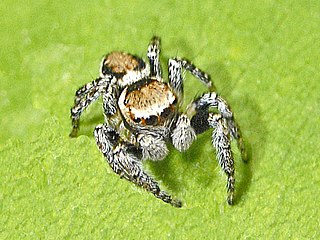
Evarcha falcata is a species of 'jumping spiders' belonging to the family Salticidae.

Prostheclina pallida is a species of spider in the family Salticidae, native to Eastern Australia. It was described by Keyserling in 1882, and remained the only species in the genus until 2007, when six more species were described.

Euophryini is a tribe of jumping spiders. It has also been treated as the subfamily Euophryinae.
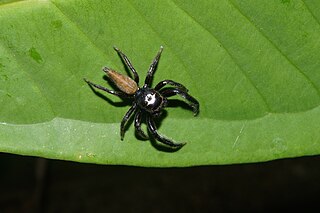
Bavia aericeps is the type species of the jumping spider genus Bavia. In its distribution range it is the most commonly found species of its genus.

Zygoballus sexpunctatus is a species of jumping spider which occurs in the southeastern United States where it can be found in a variety of grassy habitats. Adult spiders measure between 3 and 4.5 mm in length. The cephalothorax and abdomen are bronze to black in color, with reddish brown or yellowish legs. The male has distinctive enlarged chelicerae and front femora. Like many jumping spiders, Z. sexpunctatus males exhibit ritualized courtship and agonistic behavior.

















